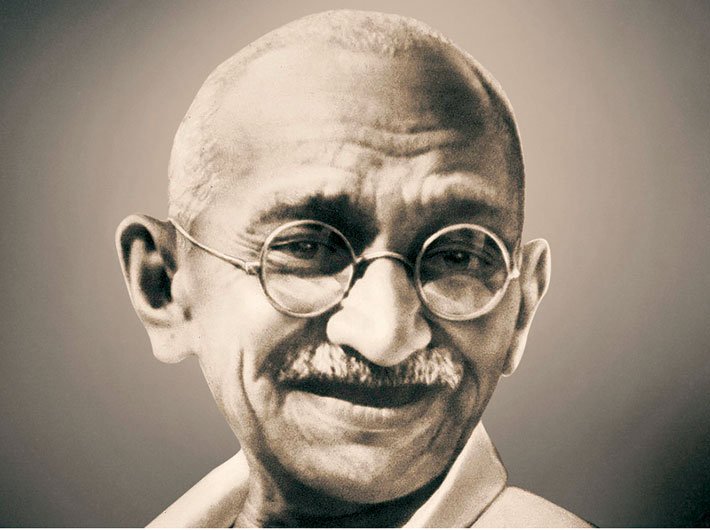A website hosted by the Sabarmati Ashram is an authentic and comprehensive source for all things Gandhian
My life is my message, said Gandhi. If you are a student of Gandhiana, you don’t have access to that life today, but it is encapsulated in his words, all of which are available in The Collected Works of Mahatma Gandhi. (The Gujarati edition bears a richly imaginative title of Gandhi’s ‘Akshar Deh’ – the body of words and the body imperishable.)
So, the task is cut out for you if you want to explore beyond the fundamental works. The task, however, is difficult – even in logistic terms. The Collected Works come in 100 volumes. The cost is not a factor, the whole set can be had in about '5,000 from the publications division. But, firstly, the edition has been out of print for long (after the revision controversy of the previous NDA regime time). Secondly, even if you get hold of one, you will need a couple of shelves to house them all.
Thus, the best recourse is a well-stocked library, in case there is one in your town. In Delhi, there is even a library dedicated to the man, in the Gandhi museum, opposite Rajghat. It has all the charms and dusty air of an old-time library. But if your town does not have a library with a set of the work under consideration, or there is one but you are short of time and want to pursue the studies at your own pace, what do you do?
Of course, the Works have been available on the net, but there was a glitch: they were in the controversially revised version with unnecessary editing and even altogether chopping off of crucial content – a sacrilege for scholars.
All of the above problems were solved more than a year ago, with the launch of the ‘Gandhi heritage portal’ (www.gandhiheritageportal.org/). Gandhi’s body imperishable is now secure in the cyberspace, thanks to a long-term project of the culture ministry, undertaken by the Sabarmati Ashram Preservation and Memorial Trust (that is, Sabarmati Ashram).
A little backgrounder: when the Mahatma’s great-grandson Tushar Gandhi announced plans to partially re-enact the historic Dandi march on its 75th anniversary in 2005, Sonia Gandhi attempted to do what Nehru too had tried: making it a Congress event. After the march, the government announced plans to maintain and commemorate not only Dandi but all those places associated with Gandhi many of which were forgotten and in disrepair.
A ‘Gandhi heritage sites panel’ was formed, which according to an official press release made two recommendations towards preservation, protection and dissemination of the tangible and intangible heritage of the Mahatma: setting up a Gandhi heritage sites mission and development of a portal to disseminate his writings in an authentic and unabridged form. The portal went online on September 2 last year.
The Sabarmati Ashram took up the task of preparing the concept design, development and maintenance of the portal. The choice was right: the ashram is the largest repository of Gandhi’s original writings and has an archive of over 6,000 images of the Mahatma and his associates. The portal project has been led by ashram trustee Kartikeya Sarabhai.
Noted Gandhi scholar Tridip Suhrud, who is the director of the trust, explains that the portal is conceptualised around The Collected Works. It has placed the collected works in three languages: English (100 volumes), Hindi (97) and Gujarati (82). These volumes are interlinked to provide easy movement from one text and language to the other. The key texts provide first editions of (when possible) of the key texts of Gandhi: Hind Swaraj, Satyagraha in South Africa, An Autobiography or The Story of My Experiments with Truth, From Yeravda Mandir, Ashram Observances in Action, Constructive Programmes: Their Meaning and Place, Key To Health and Gandhiji’s translation of the Gita as Anasakti Yoga.
The journal section provides electronic versions of the periodicals Gandhi edited including the Indian Opinion, Navajivan and Young India. There is even a sub-section with some of the journals related to the Gandhian imagination and scholarship, for example, Gandhi Marg and Bhoomi Putra. More journals are being added. Of course, the portal also has a ‘gallery’ of audio, visual, film material as well as caricatures, paintings and postage stamps.
The result, as the tallest Gandhian among us today, Narayan Desai, puts it in a documentary video on the portal, is an attempt to put within finite boundaries what is essentially infinite. That humble attempt can introduce the younger generation to the Mahatma: Gujarat Vidyapeeth vice-chancellor and ashram trustee Sudarshan Iyengar said this generation’s interaction with Gandhi is more likely to be in the electronic world than in print.
Of course, the portal is conceived to be much more than just an electronic library. Sarabhai says in the documentary, “From an initial stage where it is an archive, an authentic source, to a stage where it is a dynamic, living forum is the whole journey of this mission.”
The portal, thus, has provided a platform to make sense of Gandhi’s heritage for our times. It can lead to renewed explorations of the ashram archives, and come up with new insights. The publication of the Gandhi-Mirabehn correspondence (see box) is an example.

